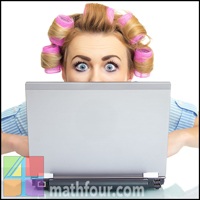 Years and years ago there was a math education model. It went like this:
Years and years ago there was a math education model. It went like this:
Children would read a section or chapter of a textbook the night before class. They would come to school the next day ready to ask questions and do hands on practice with a teacher close by to help.
This was a “normal” classroom situation.
Over the course of many years, textbook publishers have squeezed more and more topics into textbooks. Thus, they have squeezed more and more detail out. Which has gotten rid of much of their value.
As math texts had their details extracted to fit more topics, children began having difficulty comprehending them. Even if they attempted to read the section the night before, the teacher would have to fully explain it during class the next day.
Thus the first flip happened!
Kids gave up altogether on trying to read math textbooks. They soon realized that the teacher’s instructions to “read the section” as homework was just an empty request. The teacher would explain all of it the next day anyway.
This model, the first flipped classroom, has sustained for quite some time.
Enter web-based video.
Fun to watch and easy to rewind, online videos allow kids to flip back the model. Because videos aren’t regulated, nor monetarily driven, anyone can make them – including people who are really good at it.
Yes, a pair of teachers at Woodland Park officially did the first flip. But check out what kids have done without teachers. They found Cousin Sal’s videos before it was ever <cue music> Khan Academy.
 They inherently knew that there could be more and that there was a better way to learn. They started watching videos at night after they didn’t get everything they needed during the day. And they started going to school the next day asking questions of their live teachers: “I saw this video on YouTube and he did it this way… can I do it like that?”
They inherently knew that there could be more and that there was a better way to learn. They started watching videos at night after they didn’t get everything they needed during the day. And they started going to school the next day asking questions of their live teachers: “I saw this video on YouTube and he did it this way… can I do it like that?”
We didn’t flip anything.
Yes, we think we’re really clever and have this great “flipped classroom” model. Guess what? We adults haven’t done squat – we’re just writing about it and making cute infographics.
Let’s give credit where credit’s due, shall we? Textbook companies drove the first flip. And kids are driving this one.
Not us.
Related articles
- [50 Word Friday] MathFour to Appear on Create Chatter TV
- Teaching Geometry with Pickles
- [50 Word Friday] A Vicious Cycle
- [50 Word Friday] Two Ways of Learning Math

This post may contain affiliate links. When you use them, you support us so we can continue to provide free content!







The textbooks companies drove the first flip by default, so I will give credit to students. : )
Indeed the textbooks were merely trying to make a buck. Kinda like the pharmaceutical companies are.
I have started collecting old math textbooks – and many are tiny! Back in the day you could ask your kids to read a few pages and then come into class and practice. Thank goodness we have online lectures that allow teachers to do this again.
Thanks, Scotti, for your comment!
The richness of the “flipped” approach gives class time an opportunity to expand on the dry factual information students gained in the lectures. The classroom should become a laboratory of experimentation, peer interaction, and solving real-world problems. So who invented this kind of classroom? 🙂
Lewis
Elevated Math
Good point!
And the answer to your question is probably the grownups who remember having not so great learning experiences in class when they were young. Indeed I had a super lame Social Studies class in the 6th grade. If I were to teach it (which I probably will to Daughter), we will create the “laboratory of experimentation” you mention. How fun it will be to discuss what people were thinking and why they made the decisions they did throughout history!
Ask the great math teachers of the world and they probably have their own stories of lame math classes – or maybe even destructive ones.
Thanks for stopping by, Lewis!